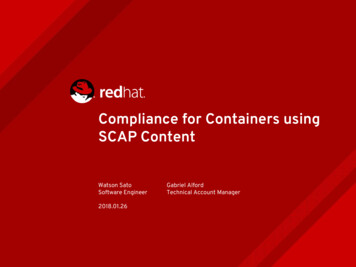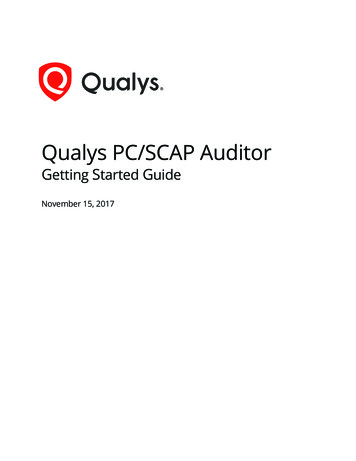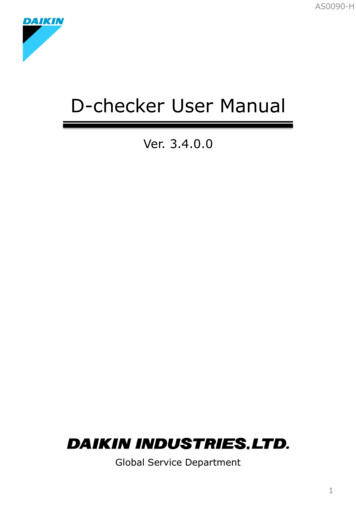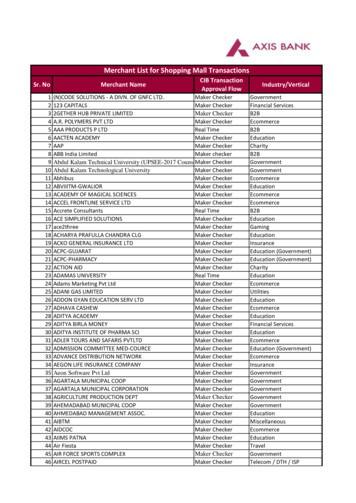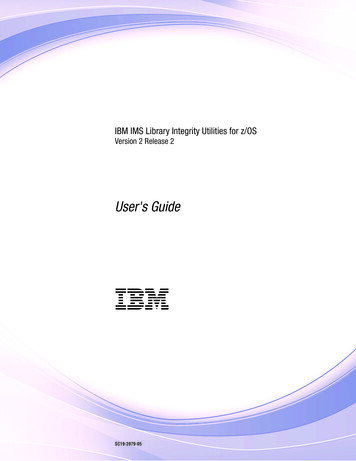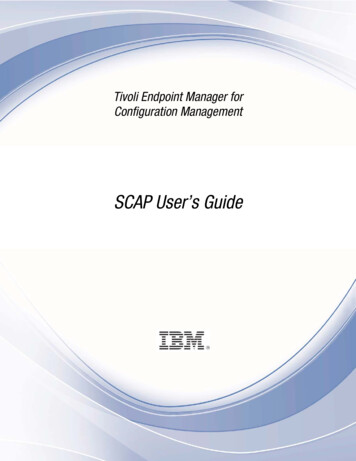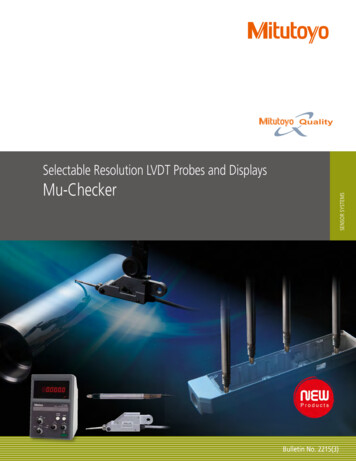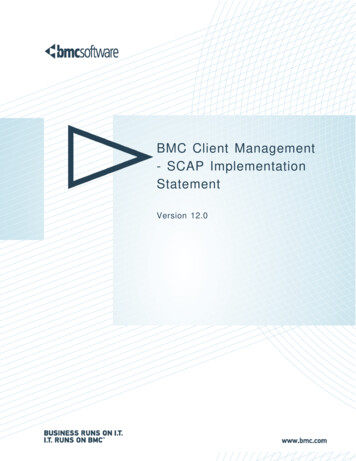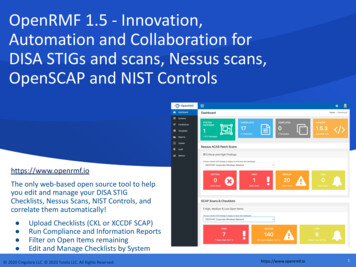
Transcription
Scap compliance checker 5.0 user manualNext
Scap compliance checker 5.0 user manual
English Nederlands logout Home / Tools List of all available tools for penetration testing. Tool count: 2817 Page 2Home / Tools / 0d1n List of all available tools for penetration testing. 0d1n Summary We're Obsessed with Your Privacy 1. Anonymous Chatting At GradeMiners, you can communicate directly with your writer on a no-name basis. 2. SecurePayment Methods We accept only Visa, MasterCard, American Express and Discover for online orders. 3. Complete Confidentiality Your personal details remain confidential and won’t be disclosed to the writer or other parties. Show Table of Contents Red Hat Enterprise Linux 8.3Abstract The Release Notes provide high-level coverage of theimprovements and additions that have been implemented in Red Hat Enterprise Linux 8.3 and document known problems in this release, as well as notable bug fixes, Technology Previews, deprecated functionality, and other details. We appreciate your input on our documentation. Please let us know how we could make it better. To do so: For simplecomments on specific passages, make sure you are viewing the documentation in the Multi-page HTML format. Highlight the part of text that you want to comment on. Then, click the Add Feedback pop-up that appears below the highlighted text, and follow the displayed instructions. For submitting more complex feedback, create a Bugzilla ticket: Goto the Bugzilla website. As the Component, use Documentation. Fill in the Description field with your suggestion for improvement. Include a link to the relevant part(s) of documentation. Click Submit Bug. In RHEL 8.3, you can configure a root password and create a user account before you begin the installation. Previously, you configured a rootpassword and created a user account after you began the installation process. You can also create customized images based on a much more reliable backend and also push images to clouds through the RHEL web console. RHEL for Edge RHEL 8.3 introduces RHEL for Edge for remotely installing RHEL on Edge servers. RHEL for Edge is an rpmostree image that you can compose using Image Builder. You can install the image using a Kickstart file and then manage the image to include image updates and to roll back an image to a previous functional state. Following are RHEL for Edge key highlights: Atomic upgrades, where the state of each update is known and no changes are seen untilyou reboot the device. Custom health checks and intelligent rollbacks to ensure resiliency. Container-focused workflows, where you can separate core OS updates from the application updates, and test and deploy different versions of applications. Optimized OTA payloads for low-bandwidth environments. For more information, see Section 5.1.2,“RHEL for Edge”. Infrastructure services The Tuned system tuning tool has been rebased to version 2.13, which adds support for architecture-dependent tuning and multiple include directives. Security RHEL 8.3 provides Ansible roles for automated deployments of Policy-Based Decryption (PBD) solutions using Clevis and Tang, and this version of therhel-system-roles package also contains an Ansible role for RHEL logging through Rsyslog. The scap-security-guide packages have been rebased to version 0.1.50, and OpenSCAP has been rebased to version 1.3.3. These updates provide substantial improvements, including a profile aligned with the CIS RHEL 7 Benchmark v2.2.0 and a profile alignedwith the Health Insurance Portability and Accountability Act (HIPAA) that is required by North-American healthcare organizations. With this update, you can now generate result-based remediation roles from tailored profiles using the SCAP Workbench tool. The USBGuard framework now provides its own SELinux policy, it notifies desktop users inGUI, and the version 0.7.8 contains many other improvements and bug fixes. Dynamic programming languages, web and database servers Later versions of the following components are now available as new module streams: nginx 1.18 Node.js 14 Perl 5.30 PHP 7.4 Ruby 2.7 The following components have been updated in RHEL 8.3: Git to version2.27 Squid to version 4.11 See Section 5.1.11, “Dynamic programming languages, web and database servers” for more information. The following compiler toolsets have been updated in RHEL 8.3: GCC Toolset 10 LLVM Toolset 10.0.1 Rust Toolset 1.45.2 Go Toolset 1.14.7 See Section 5.1.12, “Compilers and development tools” for more information.Identity Management The Rivest Cipher 4 (RC4) cipher suite, the default encryption type for users, services, and trusts between Active Directory (AD) domains in an AD forest, has been deprecated in RHEL 8. For compatibility reasons, this update introduces a new cryptographic subpolicy AD-SUPPORT to enable support for the deprecated RC4encryption type. The new subpolicy allows you to use RC4 with RHEL Identity Management (IdM) and SSSD Active Directory integration solutions. See Section 5.1.13, “Identity Management” for more information. The web console The web console provides an option to switch between administrative access and limited access from inside of a usersession. Virtualization Virtual machines (VMs) hosted on IBM Z hardware can now use the IBM Secure Execution feature. This makes the VMs resistant to attacks if the host is compromised, and also prevents untrusted hosts from obtaining information from the VM. In addition, DASD devices can now be assigned to VMs on IBM Z. Desktop andgraphics You can now use the GNOME desktop on IBM Z systems. The Direct Rendering Manager (DRM) kernel graphics subsystem has been rebased to upstream Linux kernel version 5.6. This version provides a number of enhancements over the previous version, including support for new GPUs and APUs, and various driver updates. SeeSection 5.1.14, “Desktop” and Section 5.1.15, “Graphics infrastructures” for further details. In-place upgrade and OS conversion In-place upgrade from RHEL 7 to RHEL 8 The supported in-place upgrade paths currently are: From RHEL 7.8 to RHEL 8.2 on the 64-bit Intel, IBM POWER 8 (little endian), and IBM Z architectures From RHEL 7.6 toRHEL 8.2 on architectures that require kernel version 4.14: IBM POWER 9 (little endian) and IBM Z (Structure A) From RHEL 7.7 to RHEL 8.2 on systems with SAP HANA. To ensure your system remains supported after upgrading to RHEL 8.2, either update to the latest RHEL 8.3 version or enable the RHEL 8.2 Extended Update Support (EUS)repositories. On systems with SAP HANA, enable the RHEL 8.2 Update Services for SAP Solutions (E4S) repositories. For more information, see Supported in-place upgrade paths for Red Hat Enterprise Linux. For instructions on performing an in-place upgrade, see Upgrading from RHEL 7 to RHEL 8. Notable enhancements include: Leapp nowsupports user input by generating true/false questions to determine how to proceed with the upgrade. You can now upgrade multiple hosts simultaneously using the Satellite web UI. The in-place upgrade is now supported for on-demand instances on AWS and Microsoft Azure, using Red Hat Update Infrastructure (RHUI). With the release of theRHBA-2021:0569 advisory, you can create custom scripts for the Leapp pre-upgrade report. See Automating your Red Hat Enterprise Linux pre-upgrade report workflow for details. In-place upgrade from RHEL 6 to RHEL 8 To upgrade from RHEL 6.10 to RHEL 8.2, follow instructions in Upgrading from RHEL 6 to RHEL 8. Conversion from a differentLinux distribution to RHEL If you are using CentOS Linux 8 or Oracle Linux 8, you can convert your operating system to RHEL 8 using the Red Hat-supported Convert2RHEL utility. For more information, see Converting from an RPM-based Linux distribution to RHEL. If you are using an earlier version of CentOS Linux or Oracle Linux, namelyversions 6 or 7, you can convert your operating system to RHEL and then perform an in-place upgrade to RHEL 8. Note that CentOS Linux 6 and Oracle Linux 6 conversions use the unsupported Convert2RHEL utility. For more information on unsupported conversions, see How to convert from CentOS Linux 6 or Oracle Linux 6 to RHEL 6. Forinformation regarding how Red Hat supports conversions from other Linux distributions to RHEL, see the Convert2RHEL Support Policy document. OpenJDK 11 is now available New version of Open Java Development Kit (OpenJDK) is now available. For more information about the features introduced in this release and changes in the existingfunctionality, see OpenJDK features. Additional resourcesRed Hat Customer Portal Labs Red Hat Customer Portal Labs is a set of tools in a section of the Customer Portal available at . The applications in Red Hat Customer Portal Labs can help you improve performance, quickly troubleshoot issues, identify security problems, and quickly deploy andconfigure complex applications. Some of the most popular applications are: Red Hat Enterprise Linux 8.3 is distributed with the kernel version 4.18.0-240, which provides support for the following architectures: AMD and Intel 64-bit architectures The 64-bit ARM architecture IBM Power Systems, Little Endian 64-bit IBM Z Make sure you purchase theappropriate subscription for each architecture. For more information, see Get Started with Red Hat Enterprise Linux - additional architectures. For a list of available subscriptions, see Subscription Utilization on the Customer Portal. Red Hat Enterprise Linux 8 is installed using ISO images. Two types of ISO image are available for the AMD64, Intel64-bit, 64-bit ARM, IBM Power Systems, and IBM Z architectures: Binary DVD ISO: A full installation image that contains the BaseOS and AppStream repositories and allows you to complete the installation without additional repositories. The Binary DVD ISO image is larger than 4.7 GB, and as a result, it might not fit on a single-layer DVD. A duallayer DVD or USB key is recommended when using the Binary DVD ISO image to create bootable installation media. You can also use the Image Builder tool to create customized RHEL images. For more information about Image Builder, see the Composing a customized RHEL system image document. Boot ISO: A minimal boot ISO image that is usedto boot into the installation program. This option requires access to the BaseOS and AppStream repositories to install software packages. The repositories are part of the Binary DVD ISO image. See the Performing a standard RHEL installation document for instructions on downloading ISO images, creating installation media, and completing a RHELinstallation. For automated Kickstart installations and other advanced topics, see the Performing an advanced RHEL installation document. Red Hat Enterprise Linux 8 is distributed through two main repositories: Both repositories are required for a basic RHEL installation, and are available with all RHEL subscriptions. Content in the BaseOSrepository is intended to provide the core set of the underlying OS functionality that provides the foundation for all installations. This content is available in the RPM format and is subject to support terms similar to those in previous releases of RHEL. For a list of packages distributed through BaseOS, see the Package manifest. Content in theApplication Stream repository includes additional user space applications, runtime languages, and databases in support of the varied workloads and use cases. Application Streams are available in the familiar RPM format, as an extension to the RPM format called modules, or as Software Collections. For a list of packages available in AppStream, seethe Package manifest. In addition, the CodeReady Linux Builder repository is available with all RHEL subscriptions. It provides additional packages for use by developers. Packages included in the CodeReady Linux Builder repository are unsupported. For more information about RHEL 8 repositories, see the Package manifest. Red Hat EnterpriseLinux 8 introduces the concept of Application Streams. Multiple versions of user space components are now delivered and updated more frequently than the core operating system packages. This provides greater flexibility to customize Red Hat Enterprise Linux without impacting the underlying stability of the platform or specific deployments.Components made available as Application Streams can be packaged as modules or RPM packages and are delivered through the AppStream repository in RHEL 8. Each Application Stream component has a given life cycle, either the same as RHEL 8 or shorter. For details, see Red Hat Enterprise Linux Life Cycle. Modules are collections of packagesrepresenting a logical unit: an application, a language stack, a database, or a set of tools. These packages are built, tested, and released together. Module streams represent versions of the Application Stream components. For example, several streams (versions) of the PostgreSQL database server are available in the postgresql module with thedefault postgresql:10 stream. Only one module stream can be installed on the system. Different versions can be used in separate containers. Detailed module commands are described in the Installing, managing, and removing user-space components document. For a list of modules available in AppStream, see the Package manifest. On Red HatEnterprise Linux 8, installing software is ensured by the YUM tool, which is based on the DNF technology. We deliberately adhere to usage of the yum term for consistency with previous major versions of RHEL. However, if you type dnf instead of yum, the command works as expected because yum is an alias to dnf for compatibility. For more details,see the following documentation: Red Hat makes Red Hat Enterprise Linux 8 content available quarterly, in between minor releases (8.Y). The quarterly releases are numbered using the third digit (8.Y.1). The new features in the RHEL 8.3.1 release are described below. Flatpak packages for several desktop applications Flatpak is a system for runninggraphical applications as containers. Using Flatpak, you can install and update an application independently of the host operating system. This update provides Flatpak container images of the following applications in the Red Hat Container Catalog: To install Flatpak containers available in the Red Hat Container Catalog, use the following procedure:Make sure that the latest version of the Flatpak client is installed on your system: # yum update flatpak Enable the RHEL Flatpak repository: # flatpak remote-add rhel Provide the credentials for your RHEL account: # podman login registry.redhat.io By default, Podman saves the credentials only until the user logs out. Optional: Save your credentialspermanently: cp XDG RUNTIME DIR/containers/auth.json \ HOME/.config/flatpak/oci-auth.json Install the Flatpak container image: flatpak install rhel container-id (JIRA:RHELPLAN-30958, BZ#1920689, BZ#1921179, BZ#1921802, BZ#1916412, BZ#1921812, BZ#1920604) Rust Toolset rebased to version 1.47.0 Rust Toolset has beenupdated to version 1.47.0. Notable changes include: The compile-time evaluated functions const fn have been improved and can now use control flow features, for example if, while, and match. The new #[track caller] annotation can now be put on functions. Panics from annotated functions report the caller as the source. The Rust Standard Librarynow generically implements traits for arrays of any length. Previously, many of the trait implementations for arrays were only filled for lengths between 0 and 32. For detailed instructions regarding usage, see Using Rust Toolset. (BZ#1883839) The Logging System Role now supports property-based filter on its outputs With this update, propertybased filters have been added to the files output, the forwards output, and the remote files output of the Logging System Role. The feature is provided by underlying the rsyslog sub-role, and is configurable via the Logging RHEL System Role. As a result, users can benefit from the ability of filtering log messages by the properties, such as hostname,tag, and the message itself is useful to manage logs. (BZ#1889492) The Logging RHEL System Role now supports rsyslog behavior With this enhancement, rsyslog receives the message from Red Hat Virtualization and forwards the message to the elasticsearch. (BZ#1889893) The ubi8/pause container image is now available Podman now uses theubi8/pause instead of the k8s.gcr.io/pause container image to hold the network namespace information of the pod. (BZ#1690785) Podman rebased to version 2.1 The Podman utility has been updated to version 2.1. Notable enhancements include: Changes: Updated Podman to 2.2.1 (from 2.0.5), Buildah to 1.19 (from 1.15.1), Skopeo to 1.2.1 (from1.1.1), Udica to 0.2.3 (from 0.2.2), and CRIU to 3.15 (0.3.4) Docker-compatible volume API endpoints (Create, Inspect, List, Remove, Prune) are now available Added an API endpoint for generating systemd unit files for containers The podman play kube command now features support for setting CPU and Memory limits for containers The podmanplay kube command now supports persistent volumes claims using Podman named volumes The podman play kube command now supports Kubernetes configmaps via the --configmap option Experimental support for shortname aliasing has been added. This is not enabled by default, but can be turned on by setting the environment variableCONTAINERS SHORT NAME ALIASING to on. For more information see Container image short names in Podman. The new podman image command has been added. This allows for an image to be mounted, read-only, to inspect its contents without creating a container from it. The podman save and podman load commands can now create and loadarchives containing multiple images. Podman will now retry pulling an image at most 3 times if a pull fails due to network errors. Bug Fixes: Fixed a bug where running systemd in a container on a cgroups v1 system would fail. The Buildah tool has been updated to version 1.19. Notable enhancements include: Changes: The buildah inspect commandsupports inspecting manifests The buildah push command supports pushing manifests lists and digests Added support for --manifest flags The --arch and --os and --variant options has beed added to select architecture and OS Allow users to specify stdin into containers Allow FROM to be overridden with --from option Added --ignorefile flag to usealternate .dockerignore flags short-names aliasing Added --policy option to buildah pull command Fix buildah mount command to display container names not IDs Improved buildah completions Use --timestamp rather then --omit-timestamp flag Use pipes for copying Added --omit-timestamp flag to buildah bud command Add VFS additional imagestore to container Allow "readonly" as alias to "ro" in mount options buildah, bud: support --jobs N option for parallel execution The Skopeo tool has been updated to version 1.2.1. Notable enhancements include: Changes: Add multi-arch builds for upstream and stable skopeo image via Travis Added support for digests in sync Added --all sync flag toemulate copy --all Added --format option to skopeo inspect command The Udica tool has been updated to version 0.2.3. Notable enhancements include: Changes: Enable container port, not the host port Add --version option The CRIU tool has been updated to version 3.15. Notable enhancements include: Changes: Initial cgroup2 support Legalizedswrk API and add the ability for inheriting fds via it External bind mounts and tasks-to-cgroups bindings ibcriu.so (RPC wrapper) and plugins (JIRA:RHELPLAN-55998) This part describes new features and major enhancements introduced in Red Hat Enterprise Linux 8.3. Anaconda rebased to version 33.16 With this release, Anaconda has beenrebased to version 33.16. This version provides the following notable enhancements over the previous version. The Installation Program now displays static IPv6 addresses on multiple lines and no longer resizes the windows. The Installation Program now displays supported NVDIMM device sector sizes. Host name is now configured correctly on aninstalled system having IPv6 static configuration. You can now use non-ASCII characters in disk encryption passphrase. The Installation Program displays a proper recommendation to create a new file system on /boot, /tmp, and all /var and /usr mount points except /usr/local and /var/www. The Installation Program now correctly checks the keyboardlayout and does not change the status of the Keyboard Layout screen when the keyboard keys (ALT SHIFT) are used to switch between different layouts and languages. Rescue mode no longer fails on systems with existing RAID1 partitions. Changing of the LUKS version of the container is now available in the Manual Partitioning screen. TheInstallation Program successfully finishes the installation without the btrfs-progs package. The Installation Program now uses the default LUKS2 version for an encrypted container. The Installation Program no longer crashes when a Kickstart file places physical volumes (PVs) of a Logical volume group (VG) on an ignoredisk list. Introduces a newmount path /mnt/sysroot for system root. This path is used to mount / of the target system. Usually, the physical root and the system root are the same, so /mnt/sysroot is attached to the same file system as /mnt/sysimage. The only exceptions are rpm-ostree systems, where the system root changes based on the deployment. Then, /mnt/sysroot isattached to a subdirectory of /mnt/sysimage. It is recommended to use /mnt/sysroot for chroot. (BZ#1691319, BZ#1679893, BZ#1684045, BZ#1688478, BZ#1700450, BZ#1720145, BZ#1723888, BZ#1754977, BZ#1755996, BZ#1784360, BZ#1796310, BZ#1871680) GUI changes in RHEL Installation Program The RHEL Installation Program nowincludes the following user settings on the Installation Summary window: Root password User creation With this change, you can now configure a root password and create a user account before you begin the installation. Previously, you configured a root password and created a user account after you began the installation process. A root passwordis used to log in to the administrator (also known as superuser or root) account which is used for system administration tasks. The user name is used to log in from a command line; if you install a graphical environment, then your graphical login manager uses the full name. For more details, see Performing a standard RHEL installation document.(JIRA:RHELPLAN-40469) Image Builder backend osbuild-composer replaces lorax-composer The osbuild-composer backend replaces lorax-composer. The new service provides REST APIs for image building. As a result, users can benefit from a more reliable backend and more predictable output images. (BZ#1836211) Image Builder osbuild-composersupports a set of image types With the osbuild-composer backend replacement, the following set of image types supported in osbuild-composer this time: TAR Archive (.tar) QEMU QCOW2 (.qcow2) VMware Virtual Machine Disk (.vmdk) Amazon Machine Image (.ami) Azure Disk Image (.vhd) OpenStack Image (.qcow2) The following outputs are notsupported this time: ext4-filesystem partitioned-disk Alibaba Cloud Google GCE (JIRA:RHELPLAN-42617) Image Builder now supports push to clouds through GUI With this enhancement, when creating images, users can choose the option of pushing to Azure and AWS service clouds through GUI Image Builder. As a result, users can benefit fromeasier uploads and instantiation. (JIRA:RHELPLAN-30878) Introducing RHEL for Edge images With this release, you can now create customized RHEL images for Edge servers. You can use Image Builder to create RHEL for Edge images, and then use RHEL installer to deploy them on AMD and Intel 64-bit systems. Image Builder generates a RHELfor Edge image as rhel-edge-commit in a .tar file. A RHEL for Edge image is an rpm-ostree image that includes system packages for remotely installing RHEL on Edge servers. The system packages include: Base OS package Podman as the container engine You can customize the image to configure the OS content as per your requirements, and candeploy them on physical and virtual machines. With a RHEL for Edge image, you can achieve the following: Atomic upgrades, where the state of each update is known and no changes are seen until you reboot the device. Custom health checks using Greenboot and intelligent rollbacks for resiliency in case of failed upgrades. Container-focusedworkflows, where you can separate core OS updates from the application updates, and test and deploy different versions of applications. Optimized OTA payloads for low-bandwidth environments. Custom health checks using Greenboot to ensure resiliency. For more information about composing, installing, and managing RHEL for Edge images, seeComposing, Installing, and Managing RHEL for Edge images. (JIRA:RHELPLAN-56676) The default value for the best dnf configuration option has been changed from True to False With this update, the value for the best dnf configuration option has been set to True in the default configuration file to retain the original dnf behavior. As a result, forusers that use the default configuration file the behavior remains unchanged. If you provide your own configuration files, make sure that the best True option is present to retain the original behavior. (BZ#1832869) New --norepopath option for the dnf reposync command is now available Previously, the reposync command created a subdirectoryunder the --download-path directory for each downloaded repository by default. With this update, the --norepopath option has been introduced, and reposync does not create the subdirectory. As a result, the repository is downloaded directly into the directory specified by --download-path. This option is also present in the YUM v3. (BZ#1842285)Ability to enable and disable the libdnf plugins Previously, subscription checking was hardcoded into the RHEL version of the libdnf plug-ins. With this update, the microdnf utility can enable and disable the libdnf plug-ins, and subscription checking can now be disabled the same way as in DNF. To disable subscription checking, use the -disableplugin subscription-manager command. To disable all plug-ins, use the --noplugins command. (BZ#1781126) ReaR updates RHEL 8.3 introduces a number of updates to the Relax-and-Recover (ReaR) utility. Notable changes include: Support for the third-party Rubrik Cloud Data Management (CDM) as external backup software has beenadded. To use it, set the BACKUP option in the configuration file to CDM. Creation of a rescue image with a file larger than 4 GB on the IBM POWER, little endian architecture has been enabled. Disk layout created by ReaR no longer includes entries for Rancher 2 Longhorn iSCSI devices and file systems. (BZ#1743303) smartmontools rebased toversion 7.1 The smartmontools package has been upgraded to version 7.1, which provides multiple bug fixes and enhancements. Notable changes include: HDD, SSD and USB additions to the drive database. New options -j and --json to enable JSON output mode. Workaround for the incomplete Log subpages response from some SAS SSDs. Improvedhandling of READ CAPACITY command. Various improvements for the decoding of the log pages. (BZ#1671154) opencryptoki rebased to version 3.14.0 The opencryptoki packages have been upgraded to version 3.14.0, which provides multiple bug fixes and enhancements. Notable changes include: EP11 cryptographic service enhancements:Dilithium support Edwards-curve digital signature algorithm (EdDSA) support Support of Rivest–Shamir–Adleman optimal asymmetric encryption padding (RSA-OAEP) with non-SHA1 hash and mask generation function (MGF) Enhanced process and thread locking Enhanced btree and object locking Support for new IBM Z hardware z15 Support ofmultiple token instances for trusted platform module (TPM), IBM cryptographic architecture (ICA) and integrated cryptographic service facility (ICSF) Added a new tool p11sak, which lists the token keys in an openCryptoki token repository Added a utility to migrate a token repository to FIPS compliant encryption Fixed pkcsep11 migrate tool Minorfixes of the ICSF software (BZ#1780293) gpgme rebased to version 1.13.1. The gpgme packages have been upgraded to upstream version 1.13.1. Notable changes include: New context flags no-symkey-cache (has an effect when used with GnuPG 2.2.7 or later), request-origin (has an effect when used with GnuPG 2.2.6 or later), auto-key-locate, andtrust-model have been introduced. New tool gpgme-json as native messaging server for web browsers has been added. As of now, the public key encryption and decryption is supported. New encryption API to support direct key specification including hidden recipients option and taking keys from a file has been introduced. This also allows the use of asubkey. (BZ#1829822) powertop rebased to version 2.12 The powertop packages have been upgraded to version 2.12. Notable changes over the previously available version 2.11 include: Use of Device Interface Power Management (DIPM) for SATA link PM. Support for Intel Comet Lake mobile and desktop systems, the Skylake server, and the Atombased Tremont architecture (Jasper Lake). (BZ#1783110) tuned rebased to version 2.14.0 The tuned packages have been upgraded to upstream version 2.14.0. Notable enhancements include: The optimize-serial-console profile has been introduced. Support for a post loaded profile has been added. The irqbalance plugin for handling irqbalancesettings has been added. Architecture specific tuning for Marvell ThunderX and AMD based platforms has been added. Scheduler plugin has been extended to support cgroups-v1 for CPU affinity setting. (BZ#1792264) tcpdump rebased to version 4.9.3 The tcpdump utility has been updated to version 4.9.3 to fix Common Vulnerabilities andExposures (CVE). (BZ#1804063) libpcap rebased to version 1.9.1 The libpcap packages have been updated to v
Scap compliance checker 5.0 user manual Next. . The scap-security-guide packages have been rebased to version 0.1.50, and OpenSCAP has been rebased to version 1.3.3. These updates provide substantial improvements, including a profile aligned with the CIS RHEL 7 Benchmark v2.2.0 and a profile aligned
